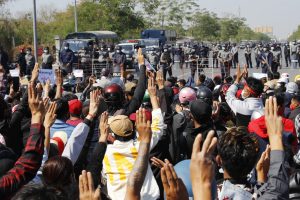[ad_1]
ASEAN Beat | Politics | Southeast Asia
So far, Myanmar’s military government has demonstrated restraint, relatively speaking, in the face of growing protests.

Protesters sitting on a road blocked by police in riot gear flash the three-fingered salute, a symbol of resistance, during a protest in Mandalay, Myanmar, Tuesday, Feb. 9, 2021.
Credit: AP Photo
Police cracked down on crowds of demonstrators against Myanmar’s military takeover who took to the streets again Tuesday in defiance of rules making the protests illegal.
Water cannons were used in Mandalay, Myanmar’s second-biggest city, where witnesses said at least two warning shots were fired to try to make the crowd disperse. Reports on social media said police arrested more than two dozen people there. They also used water cannons in the capital Naypyidaw for a second day running and fired shots into the air.
The protesters are demanding that power be restored to the deposed civilian government and are seeking freedom for the nation’s elected leader Aung San Suu Kyi and other ruling party members detained since the military took over and blocked the new session of Parliament from convening on February 1.
The growing defiance is striking in a country where past demonstrations have been met with deadly force and are a reminder of previous movements in the Southeast Asian country’s long and bloody struggle for democracy. The military used deadly force to quash a massive 1988 uprising against military dictatorship and a 2007 revolt led by Buddhist monks.
The decrees issued Monday night for some areas of Yangon and Mandalay banned rallies and gatherings of more than five people, along with motorized processions, while also imposing a 8 p.m. to 4 a.m. curfew. It was not immediately clear if regulations have been imposed for other areas.
Demonstrations Tuesday were also held in other cities, including Bago — where city elders negotiated with police to avoid a violent confrontation — and Dawei, and in northern Shan state.
In Magwe in central Myanmar, where water cannons were also used, unconfirmed reports on social media claimed several police officers had crossed over to join the protesters’ ranks. A police officer in Naypyidaw was also said to have switched sides.
Crowds also gathered in Yangon, the country’s biggest city where thousands of people have been demonstrating since Saturday, despite a heightened security presence. No violence was reported.
Soldiers do not appear to have been deployed yet to stop the demonstrations, a small indicator of restraint by the military government. The army has a record of brutality in crushing past revolts as well as in fighting ethnic minorities in border areas seeking self-determination. It also has been accused of carrying out genocide in its 2017 counterinsurgency campaign that drove more than 700,000 members of the Muslim Rohingya minority across the border to seek safety in Bangladesh.
State media for the first time on Monday referred to the protests, claiming they were endangering the country’s stability.
“Democracy can be destroyed if there is no discipline,” declared a statement from the Ministry of Information, read on state television station MRTV. “We will have to take legal actions to prevent acts that are violating state stability, public safety and the rule of law.”
However, the military commander who led the coup and is now Myanmar’s leader made no mention of the unrest in a 20-minute televised speech Monday night, his first to the public since the takeover.
Sen. Gen. Min Aung Hlaing instead repeated the claims about voting fraud that have been the justification for the military’s takeover, allegations that were refuted by the state election commission. He added that his junta would hold new elections as promised in a year and hand over power to the winners, and explained the junta’s intended policies for COVID-19 control and the economy.
Reporting by the Associated Press from Yangon, Myanmar.
[ad_2]
Source link